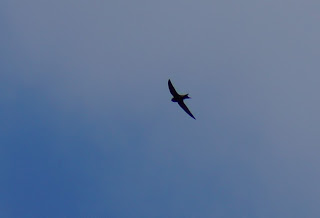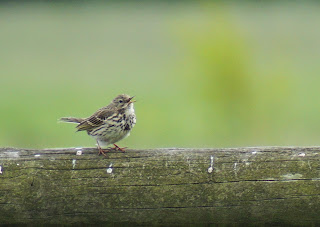I've had to edit yesterdays blog post as I had mis-identified three of the critters. The Shield Bug is in fact a Dock Bug, which I should have known as I've photographed them before. The Black-veined White is in fact a male Green-veined White, and I'm not surprised I got that one wrong as I always struggle with my white butterfly ids. And lastly, but most excitingly, the Southern Hawker dragonfly is actually a male Hairy Dragonfly and it's only Maple Lodges third record of one on site.
So great news and I'm glad the hour I waited for the dragonfly to finally land for a photo was worth it. And finally thanks to Martin Parr for putting me right.
After spending all of Friday home ill, I was maybe a bit too ambitious in spending all day out yesterday at Maple Lodge. This morning when I woke up I felt completely wiped out, and instead of my usual 8-9 hour jaunt at Cranford Park, today I lasted a measly three hours only and most of that was spent sitting down.
 |
| This photo is taken from sitting on one of my favourite logs in the woods looking down the path that leads out to the Headland area. |
 |
| This photo is taken from the wood circle, another favourite perch of mine, looking back towards the Information Centre. Natures own colour scheme. |
I had five 'first for the year at Cranford Park' sightings today, but could only get photos of three of them. The first was a stunning fresh male Small Copper butterfly. It was in the Headland area of the park and as I tried to focus my camera on it, the little lovely fluttered off and I couldn't relocate it.
The second was a Five-spot Burnet, a day flying moth, that I found around the wildlife pond in front of the Information Centre. Again by the time I had got my camera in focus the moth had flown and I couldn't relocate it.
The third was my first damselfly at Cranford Park this year. A rather beautiful male Blue-tailed damselfly that I found in the woods....
my fourth was my first female Holly Blue, also found in the woods....
I've been seeing male Holly Blues for some time now, but not had a female until today.
And finally my fifth was my first female Large White of the year...
I had to get help from James Wright on identifying this one correctly. As I stated above I find white butterflies very hard to id sometimes.
The Bluebells are starting to go over, but Cranford Woods did have one of the best displays I've seen this year. The scrub clearance the grounds men done really worked a treat and there were lots more Bluebells to be seen this year than in previous years. A credit to Alison Shipley and her crew of merry workers.
 |
| Bluebell seed heads |
Even though our lovely wild native Bluebells are almost at the end of their season, they are still attracting the butterflies....
 |
| Peacock |
 |
| male Orange-tip |
The Red/Pink Campion is also attracting the flutterbyes too....
 |
| another Peacock...you just have to love their garish colours |
 |
| and a female Orange-tip. Not the best photo as taken at some distance |
In the ever growing grassy meadows there are hundreds of Buttercups now, and inside practically every one of them was a Flower Beetle today. The one below is known as a Fat-legged or Thick-legged Flower Beetle but only the males have those generous sized thighs.....
In the skies over the meadow I found Swifts...
a couple of House Martins (no photo) and a Swallow (no photo).
I also saw the regularly sighted Buzzard.....
Also in the meadow area both Skylarks and Meadow Pipits were singing away. I had walked almost all the way across the meadow sticking to the same grass path way, when I heard a Mipit calling and glanced around to see one perched very handily on one of the tree guards.....
A few steps back, and still staying on the path way, I spent a lovely ten minutes with this little beauty....
It was quite content to walk all around the tree guard as it obviously wasn't threatened by me in any way. Luckily I have a zoom lens on my camera, so was able to capture the beautiful markings on this little Mipit without disturbing it or feeling I had to get closer to get the ultimate photo. You really have to respect these ground nesting birds at this time of year. Stick to the grass path ways. That's what they are there for.
So it was a nice finale to my weekly visit at Cranford CP. As I wasn't quite feeling myself today I didn't do the whole circuit so there was probably plenty that I missed.
However one thing I didn't miss was whilst I was in the woods I heard the Kestrels calling, and found the male high in a tree. The calling however was coming from the female, and as I watched she flew over to the male, took something off him that I hadn't noticed he had under his talon, then flew to another tree. I strongly suspect I accidently stumbled across their nest, and that the female is on eggs. It is not the same nest tree as last year, but then again last years nest site wasn't the same as the year before.
Although Kestrels are not Schedule 1 nesting birds, and therefore are not covered by the same protection as the Hobbys have, I wont be disclosing where the nest tree is.
In July we will all be able to enjoy and see the juveniles out in the meadows learning how to hunt.











Lovely photos Wendy.
ReplyDeleteJust discovered your blog after perusing the Butterflies and Moths Facebook group. Wonderful stuff! Already added to my Netvibes environment feeds and looking forward to more posts!
ReplyDelete